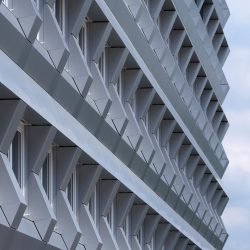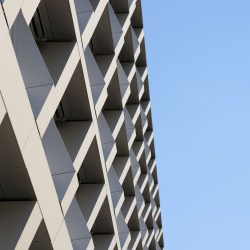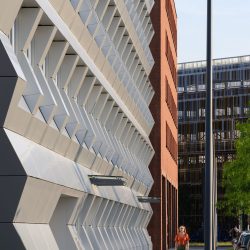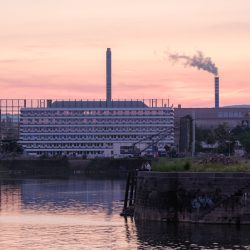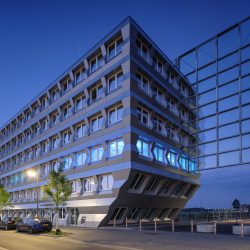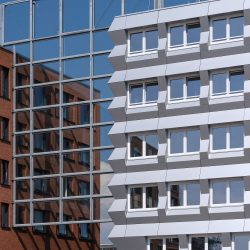
MVRDV . photos: © Ossip van Duivenbode . + archdaily
Like many of Europe’s formerly industrial harbor areas, Mainz’s Zollhafen is undergoing a transformation into a modern city quarter. Located northeast of the city’s Neustadt district on the west bank of the river Rhine, the former shipping container harbor will be converted into an urban mix of living, working, and leisure facilities, a significant urban transformation that will be one of the most important regeneration projects in the city’s recent history. ZigZag is one of the pioneer projects in this large-scale transformation.
The 4,600m2 building is the defining feature at the northern end of the harbor basin; located on the newly renamed Rotterdamer Platz, it opens onto the new waterfront square while acting as a noise buffer between the new urban quarter and the remaining industrial zone further to the north. To further reduce the noise impact on the new housing blocks, the design features an additional soundproof wall, consisting of a steel frame with glass panel infills that spans between ZigZag and its neighbors.
The façade of the six-story building features a ”folded skin” of matt-silver coated aluminum panels, responding to the urban framework for the Zollhafen area. The depth of the elements allows external sunshades to be integrated and reduces glare. Light reflections from the silvery cladding emphasize the 3D visual effect to reinforce the sculptural impression of the building. On the ground floor, the zig-zagging façade tapers inward, providing extra outdoor space and opening up generous sightlines and pathways from the street to the water’s edge.
The interior can accommodate multiple tenants; people will access ZigZag via two independent lobbies on the ground floor, which also hosts a catering area on the waterfront. From the second to fifth floor large, open spaces allow tenants the maximum possible flexibility in fitting out their offices, enabling everything from individual offices to open space solutions. The building incorporates modern, future-oriented office features such as smartphone-controlled lighting and temperature levels, while wireless solutions have been included throughout the building.
_









